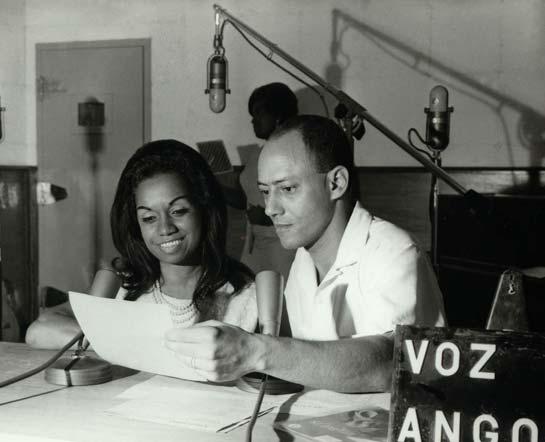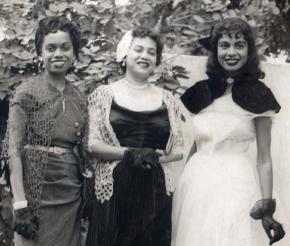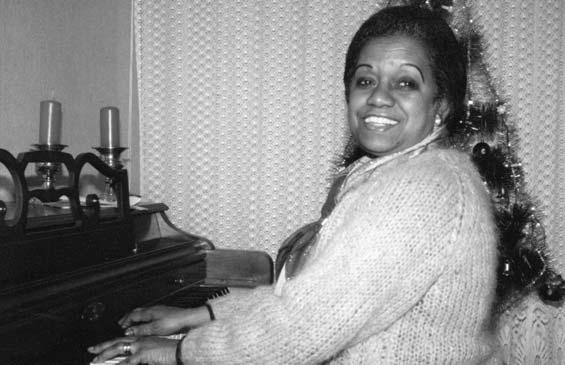Ana Maria de Mascarenhas free of any mask
Many years ago, a man called Xavier de Mascarenhas disembarked. He was of Indian origin and from him other families had their origin. Among them was a family of many children, and among these Ana Maria de Mascarenhas, born in Luanda in 1929. She was destined to be someone special.
When she was 12, she went to the private school run by Lilly Pardal de Anapaz who was a teacher. There she studied musical theory, solfeggio and the piano, using the Viana da Mota method. Lilly Pardal had been a student of his. She joined the children’s group “Os Cábulas e as Formigas” and later the theatre group “De Tanga”.
Several years later, she joined the Luanda cathedral choral society where, with her sisters, she stayed for around 12 years, taking part in mass sung in Latin or Portuguese. She then formed a trio with her sisters Mimi and Tézinha (known as the Irmãs Mascarenhas). On stage they were always backed by the Ngola Ritmos group.
Towards the end of the 60s, the Musical Academy was set up in Luanda. Those pupils who attended also had to be enrolled in the National Conservatoire in Lisbon if they wanted their studies to be officially recognised.
![Piano audition in the Rádio Clube de Angola [in the 40s] Piano audition in the Rádio Clube de Angola [in the 40s]](https://www.buala.org/sites/default/files/imagecache/half/austral-60---pag46-a-51-5.jpg) Piano audition in the Rádio Clube de Angola [in the 40s]
Piano audition in the Rádio Clube de Angola [in the 40s]
She made many acquaintances during her time with Lilly Anapaz but she also wanted to develop her musical skills, and so she enrolled in the Luanda Musical Academy and started studying again. As a result she obtained a diploma in the General Course of Theory and Solfeggio and the General Course in Singing awarded by the National Conservatoire in Lisbon.
In the final audition on the course she sang the soprano part in the duet ‘La ci daren la mano’ from Mozart’s opera D.João. She was accompanied by another finalist, Raul Miranda, who sang the bass part. Also as a soprano, she was the singer in the “Fantasia para 7 Instrumentos”, under the director of composer and conductor Jayme Mendes in the National Theatre and Cinema in Luanda.
From then on she was to receive a number of official invitations from the Luanda City Council and she never refused one. There were also invitations from the mayor, António Videira, to be on the jury for the city festival.
In 1972 she was already employed in a private capacity for the Finance Services and in addition she became teacher of musical education at preparatory level in the General Victor school in Luanda, on the Catete road. By this time she already had her infants’ teacher diploma and on top of everything she was the head of the National African League primary school.
In 1973 she took part in the musical session put on by the teachers’ course at the Luanda Musical Academy. The session was directed by the teacher and composer Cândido Lima and was sponsored by the Gulbenkian Foundation.
Everything learnt as a pupil of Lilly Anapaz, her singing teacher, Mário Duque and Maria Emília de Leite Velho (both from the Luanda Musical Academy), went into the making of composer and songwriter Ana Maria de Mascarenhas.
Her compositions were first known only in a small inner circle, but with the Luanda Song Festival, her work became known to a wider public. In the 60s she had formed a duo with the Portuguese journalist Adelino Tavares da Silva, who had just arrived in Angola. They composed four or five songs together and then registered in the Portuguese Writers’ Association, with Adelino as songwriter and Ana Maria as composer. It can be said that the duo revolutionised the Song Festival, when Maria Provocação was performed by Sara Chaves and Mulata é a Noite by Concha de Mascarenhas. They were both accompanied by Ngola Ritmos, the Angolan rhythm group.
 At the radio microphones in Angola, with the presenter José Guize
At the radio microphones in Angola, with the presenter José Guize
Ana Maria and Tavares da Silva had started with songs as messages, songs with a local flavour: Senhora da Muxima, Sangazuza, Benguela – Rua 9, Mulata Maldita, Canção do Asfalto Molhado (it’s impossible to mention them all) but in the festivals they entered they were always in or near the top spot.
The two split up in 1968. From then on, Ana Maria competed as composer and songwriter. Balada de Todo o Tempo, Meu Mundo Novo, No Silêncio das Flores, Canção da Vida all won prizes. A line had to be drawn …
Ana Maria was invited to be on the next jury for the Luanda Song Festival. She accepted and she stopped entering for competitions! But she carried on composing - Mukonda ya kitari, Luandos ao Luar, Manhê, manhê, Angola Nova, Canção Nostalgia and many others besides, they carried on being sung and recorded.
You are missing some Flash content that should appear here! Perhaps your browser cannot display it, or maybe it did not initialize correctly.
In No Nosso Tempo de Inocência Ruy Legot was the first artist to sing one of her early songs – Acorrentada. Years later, the composition was re-issued by the pair and was recorded as a single by the Portuguese fado singer Celeste Rodrigues, entitled Gaivota Perdida. Others who have sung and recorded Ana Maria’s music include Lourdes Resende, Artur Rodrigues, the Agua Viva group (from Spain), Los Indios Paraguaios, Agostinho dos Santos and Martinho da Vila (the Brazilians). Maria Provocação won the first festival prize for Sara Chaves and the Ngola Ritmos. It then reached international acclaim through the Duo Ouro Negro (the first on LP, the second by Artur Rodrigues as a single and the third as an LP by Martinho da Vila).
 The Irmãs Mascarenhas Trio, Ana Maria, Mimi and Tazinha
The Irmãs Mascarenhas Trio, Ana Maria, Mimi and Tazinha
Mulata é a Noite won first prize for Concha de Mascarenhas and was recorded straight after the festival as a single by Agostinho dos Santos. Others who have sung and still sing her songs include Cirineu Bastos, Lilly Tchiumba, Milita, Fernanda Ferreirinha, Dionísio Rocha, Rui Legot, Carlos Burity and Carlitos Vieira Dias. Her development as a poet first began when a cousin, Luís Barbosa Bessa, pointed out that she spoke in verse. He offered her books containing poetry by Marta Mesquita da Câmara and Florbela Espanca. She was in her teens, and she fell in love with the sonnet. Her “second father” – the family godfather, Lourenço Mendes da Conceição – found out and offered her a work on the sonnets of Luís de Camões for her to study the composition, metre and rhymes of the poems. And she never looked back. She grew up writing poetry and composing songs. There is an anthology with most of her works, in MS, and works for a CD of tangos. Both are pending …
When she was invited to leave her country in April 1975, she also had to give up her job. She was a broadcaster and producer at the Voz de Angola, which is now Rádio Nacional. Here she played her own compositions for seven years on the programme Rádio-Teatro and two polemical programmes which are still remembered (Momento de Mulher and Tempo de Acção). These set out her position in the Angolan revolutionary process, where she always fought against any kind of injustice. And so she settled in Lisbon.
 Ana Maria playing piano at home, Coqueiros, Luanda.
Ana Maria playing piano at home, Coqueiros, Luanda.
She did not want to stop studying music and enrolled on an intensive course at the Centre for Gregorian Studies, where she learned of the WARD method. She worked on her vocals, gestures, musical sayings and phraseology, improvisation and rhythms in 1976. She then settled in Guarda, where her then husband’s professional career had taken him. In 1978, here she is, giving lessons in the town’s junior school as a teacher in musical education for early schooling. She is strong but the town is cold and she has soon had enough. In 1981 she returns to Lisbon, where she carries on writing and composing.
in AUSTRAL nº 60, article kindly provided by TAAG - Linhas Aéreas de Angola